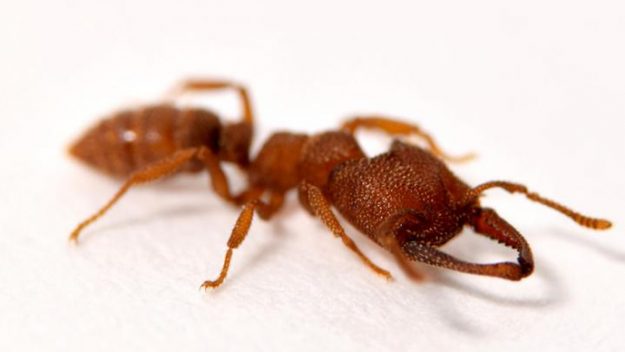
Ant fastest animal? its killer jaws are nature’s fastest at 320km/h.
A TINY ant that drinks the blood of its own young to survive has been named the world’s fastest animal.
The Dracula ant, a feisty bug found only in Madagascar, boasts spring-loaded jaws that it uses to batter its foes at speeds 5,000 times faster than the blink of an eye.
The crushing weapon, a pair of limb-like organs called mandibles that extend from the mouth, can hit speeds of up to 90 metres per second, or 200 miles per hour, a new study shows.
They are so fast that they can propel smaller insects into the air, and give larger intruders a sting they won’t soon forget.
Dracula ant mandibles shift faster than those of the trap-jaw ant, which have clocked speeds of 145 miles per hour, as well as the mantis shrimp, whose 50-mile-an-hour punch can shatter aquarium glass.
This makes the bug’s jaw snap the fastest animal movement on record, say scientists from the University of Illinois.
They combined high-speed footage with state-of-the-art X-ray scans to see the Dracula ant’s weapon in action – inside and out.
“Scientists have described many different spring-loading mechanisms in ants, but no one knew the relative speed of each of these mechanisms,” said study author Fredrick Larabee.
“We had to use incredibly fast cameras to see the whole movement. We also used X-ray imaging technology to be able to see their anatomy in three dimensions.”
The study showed that, unlike other spring-loaded ant jaws, the Dracula ant power up their mandibles by pressing the tips together under extreme forces.
To fire the weapon, one mandible slides over the other, releasing the pressure like a snap of the fingers, researchers said.
“The ants use this motion to smack other arthropods, likely stunning them, smashing them against a tunnel wall or pushing them away,” said study author Professor Andrew Suarez.
“The prey is then transported back to the nest, where it is fed to the ants’ larvae.”
Dracula ants are smaller than a sesame seed, and named after their gruesome feeding habits.
The bugs feed on the blood of their own larvae, making small incisions and carefully drinking just enough to avoid killing their victim.
They were only discovered in 1994, and have bodies shaped more like a wasp than an ant.
Little is known about the mysterious species, but some scientists have suggested they are a ‘missing link’ in the ant evolutionary tree.
In future, the researchers hope to pin down precisely how the Dracula ant uses its mandibles to hunt down prey and defend its nest.
The study was published in the journal Royal Society Open Science.













